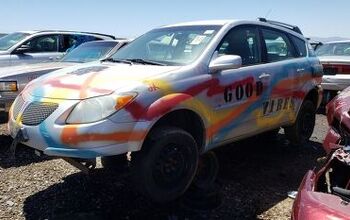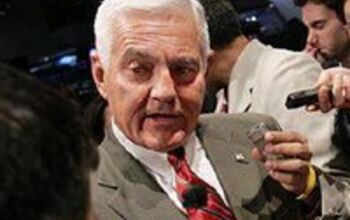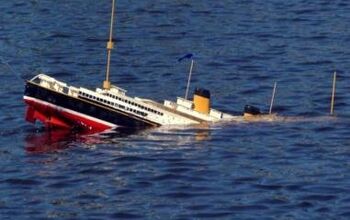General Motors Death Watch 238: No, No, Nadir
You knew this would happen. Whenever things go wrong or come to an end we can’t help but look back and try to figure out why. To look for that one pivotal event that changed the course of events forever. So what did it for GM? When did it happen? After careful analysis I pinpoint their demise to the 3.8L V6 (a.k.a the 231) of the 1970s.
First, the runners up and why they didn’t make the final cut. The Corvair certainly garnered a lot of bad press for being “Unsafe At Any Speed.” For all of its bad points, including the gas fired heater, it just wasn’t that bad of a car. Furthermore, it was a niche vehicle and never sold in enough numbers to really cause any permanent damage to the then-mighty GM. Remember, in the 1960s GM was responsible for selling over 50% of the vehicles in the US. Many look back at the Corvair as nothing more than an experiment that didn’t work.
Fast forward to the early 1970s. GM introduces the Vega, its response to the fuel efficient imports, just in time for the oil embargo of 1973. To say the Chevy Vega was ill-conceived is an understatement. First, the GM hierarchy dismissed the warnings of their engineers that an aluminum engine block needs cast iron liners. Then they outsourced cheap Japanese steel that turned to aluminum foil after just a few winters. It was clearly a losing situation for GM as they got bogged down spending millions sidelining cars to replace engines and recalling others to replace fenders.
So why didn’t the Vega make the final cut? Truth be told it just wasn’t the meat of the market for GM then. Furthermore, the public was just starting to accept little cars that ran on four cylinders and many didn’t believe a four cylinder could be durable enough to hold up in the long run anyway.
Which brings us to our winner: the 3.8-liter V6. Or the 231, as it was more commonly known back then (it was more common to refer to engine size in cubic inches not liters). It quietly appeared on the scene then gained wide spread use in 1978. That year saw a major redux across the A-body line: Oldsmobile Cutlass, Pontiac Grand Prix and the Buick Regal. These were General Motors’ bread and butter products and they were wildly successful. And it is here that GM makes its final, fatal collision; the corporate Titanic hitting the metaphorical iceberg.
GM sent these cars out of the factory with a multitude of quality glitches of which 231 engine issues were no small part. The oil pump was poorly designed, causing the oil pressure to sink dangerously low. By the time the consumer figured out something untoward was happening, the engine was apt to have blown a bearing or, worse, seized up. Game over. If your 231 engine didn’t throw a bearing, there were transmission “issues.” Cracked springs in the suspension. Rear wheel cylinders that fell off of their backing plates. All of this pushed many in the public towards their GM repair shop, and then, imports. The rest, as they say, is history.
Looking back, GM should have jumped in and cleaned up this multifarious mechanical disaster with honor and swiftness. At the time, they had enough cash to make all their customers whole. It would have been an extremely expensive PR disaster, but pretending there wasn’t a problem sealed their fate with hundreds of thousands of former loyalists.
GM tried to run from the warranty claims. Worse, they continued producing the 231 well into the 1980s. In the years that followed, it was mostly more of the same. GM sent out V8s with soft camshafts, torque steering X-cars and Fieros a quart low on oil. As the quality issues stacked up, GM’s market share deteriorated.
In the 1990s, they had one last chance. Cash rich from the SUV craze, GM could have re-invested the profits into their cars to make them mechanically-bulletproof world-beaters. Sadly, they squandered on brands and products and deals they didn’t need. And so here we sit in 2009, trying to bail them out, trying to figure out how to turnaround a submerged leviathan.
The astute reader will have noticed that I’ve left out the Chevrolet Monte Carlo, the other model built off the A-body and a major player in 1978. The Monte Carlo also had a 3.8-liter V6. But that engine was derived from a Chevrolet design: it had 229 cubic inches, not 231. Those two cubic inches helped make the 229 much more sprightly. And durable. If GM had used the 229 in the rest of their divisions . . .
Imagine that: two measly cubic inches could have changed the course of GM forever. Then again, I doubt it. When a company can’t recognize, admit and correct its mistakes, it’s a rudderless ship bound to hit something, eventually.
More by Charles Dagastino
Latest Car Reviews
Read moreLatest Product Reviews
Read moreRecent Comments
- Lou_BC Well, I'd be impressed if this was in a ZR2. LOL
- Lou_BC This is my shocked face 😲 Hope formatting doesn't fook this up LOL
- Lou_BC Junior? Would that be a Beta Romeo?
- Lou_BC Gotta fix that formatting problem. What a pile of bullsh!t. Are longer posts costing TTAC money? FOOK
- Lou_BC 1.Honda: 6,334,825 vehicles potentially affected2.Ford: 6,152,6143.Kia America: 3,110,4474.Chrysler: 2,732,3985.General Motors: 2,021,0336.Nissan North America: 1,804,4437.Mercedes-Benz USA: 478,1738.Volkswagen Group of America: 453,7639.BMW of North America: 340,24910.Daimler Trucks North America: 261,959


































Comments
Join the conversation
Pete, My sister bought an '84 Sunbird (J body)in '89 for going off to school. It had 50,000 miles on it at the time. I think it went through 6 alternators in the next 5 years and 60,000 miles. It got to the point that she could replace the alternator faster than I could on that car. It would also blow head gaskets if you probed it's top speed which was well north of 90mph. My twin sister then inherited it. It actually became more reliable with her than my older sister. I seem to only remember doing routine maintenance on it. Once it got away from my big sis and into my other sister's hands, it actually was a decent car if you kept it within it's limits. She then traded up to a '99 Maxima, and then later on a BMW. The 'Turd died an untimely death at the hands of a young driver. not long after we sold it. Which was good, as I don't think the 1.8 would have lasted too much longer, the cam bearings (or lack of) were shot and the bottom end was getting noisy.